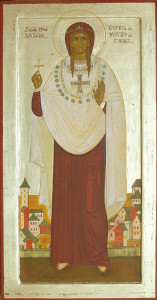Rags to riches stories are always appealing. What child has not thrilled to the story of Cinderella, who went from being neglected and given the worst of the household chores by her step-sisters to being the Prince’s choice for his bride? And what American does not admire the success stories of entrepreneurs Dave Thomas (Wendy’s) and Truett Cathay (Chick-Fil-A) who started from very humble beginnings and built fast-food empires? The stories of the lives of the saints of the Church also include such “rags to riches” tales and these stories show us how we should measure “success” and what we should do with our material wealth.
St. Bathilde’s story is one such tale. She was an Anglo-Saxon born around 626-7 along the eastern coast of England. As a teenager, she was kidnaped by marauding Danes and then sold into slavery in the household of Clovis II, king of the Franks. Given domestic chores in the palace, Bathilde approached her new station in life with patience and humility. She did her work well and was kind and cheerful to all around her. Her intelligence and beauty were soon noticed by Erchinoald, the chief steward of the palace, who was a widower. He wished to marry again and thought that this slave girl would make a good wife. Bathilde did not wish to marry him or to cause envy among the other slaves, so she dressed herself in old rags and tried to stay out of sight for awhile. Thinking that the girl had probably run away, Erchinoald chose another wife instead.
Resuming her normal clothes and continuing her work among the other slaves of the household, Bathilde once again was admired by all for her good nature and her charitable acts toward others. Soon she was noticed by another official – the young king himself! This time, the slave girl did not hide herself, but slowly came to accept the love and attention the king offered. She agreed to marry him and, at the age of 19, she became Queen Bathilde of Neustria and Burgundy.
In her new position, Bathilde found herself with all the trappings of royalty: prestige and honor, wealth, fine clothes, and a very comfortable life. But she never forgot what it was like to be a slave – to be without possessions and freedom. So she made certain that one of her main projects as queen was to buy and free slaves, especially children, whenever possible.
Bathilde and King Clovis had three sons: Clotaire, Childeric and Theuderic. Clovis died early, leaving Bathilde a widow with three young children, and when the five-year-old Clotaire succeeded his father as king, his mother became regent and managed royal affairs for her child. Her wisdom and fair judgements brought her respect from all the people. She continued her work against child slavery and gained an ally in this work in Bishop (St.) Eligius of Noyon and Tournai. He, too, had begun his life at court in humble circumstances – as an apprentice goldsmith – and was acutely aware of the need for advocates for slaves.
Another of Queen Bathilde’s projects was the founding and support of monastic houses. Through her generosity, the abbeys of Corbie and Chelles were founded and she also contributed to those at Jumieges, Jouarre and Luxeuil.
When her sons were grown and had become kings of different areas of the Frankish territories, Queen Bathilde retired to the Abbey of Chelles for the remainder of her life. Here she was buried after her death on January 30, 680. She was honored for her saintly life immediately following her death and was officially named a saint before the year 900. Not all historians have been kind to the memory of St. Bathilde, but it is now believed that a confusion of her with another person led to these unjust portrayals.
May we learn from St. Bathilde how to face the humiliations and disappointments of our lives with patience and charity. May we also learn to receive the triumphs and successes of our lives with humility and generosity. May we, like her, remember those who need our help and may we look to the monastics for spiritual aid. Holy Bathilde, pray for us.
